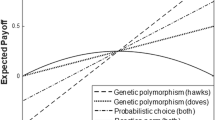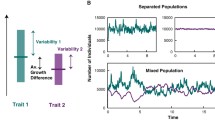Summary
Many natural populations undergo radical and unpredictable fluctuations, associated with stochastic environmental conditions. Under such circumstances, fitness of a genotype (or ‘strategy’) is defined as the geometric mean of the intergenerational genotypic population growth ratel(t). Unfortunately, this population-level criterion has proved difficult to apply at the level of individual organisms.
After developing a formula for the variance ofl as the sum of developmental and environmental variance, we discuss several models of individual adaptations, involving clutch size, progeny size and number, and foraging behaviour under risk of predation, based on the geometric-mean fitness concept. We then show how the method of dynamic programming can be extended to deal with facultative behaviour in stochastic environments. Finally we discuss the concept of an evolutionarily stable strategy in a stochastic environment.
Our analysis suggests several novel interpretations of field and laboratory observations. Under the geometric mean criterion behaviour may be determined primarily by the worst likely environment; behaviour may appear suboptimal if observed only under normal or average conditions. For example,except under extreme environmental conditions, avian clutches larger than those that are observed might result in increased fecundity, with little if any cost of reproduction in terms of parental survival; however, in unusually bad years such large clutches might be disastrous, in terms of parental survival. This consideration may help explain some recently reported experimental clutch-size manipulation results. Similarly, our analysis indicates that the known phenomenon of seasonal reduction in seed size may constitute a double bet-hedging strategy, determined by parental mortality risk and future seed survival probability. We also discuss circumstances in which phenotypic polymorphism is an adaptation to environmental uncertainty. Thus almost any individual life history or behavioural adaptation may be affected by environmental stochasticity.
Similar content being viewed by others
References
Boyce, M. and Perrins, C. M. (1987) Optimizing great tit clutch size in a fluctuating environment.Ecology 68, 142–53.
Brown, J. S. and Venable, D. L. (1986) Evolutionary ecology of seed-bank annuals in temporally varying environments.American Naturalist 127, 31–47.
Caraco, T. (1981) Risk sensitivity and foraging groups.Ecology 62, 527–31.
Cavers, P. B. and Steel, M. G. (1984) Patterns of change in seed weight over time on individual plants.American Naturalist 124, 324–35.
Clark, C. W. and Ydenberg, R. C. (1990) The risks of parenthood. II. Parent-offspring conflict.Evolutionary Ecology 4, 312–25.
Cohen, D. (1966) Optimizing reproduction in a randomly varying environment.Journal of Theoretical Biology 12, 119–29.
Cooper, W. S. and Kaplan, R. H. (1982) Adaptive “coin-flipping”: a decision-theoretic examination of natural selection for random individual variation.Journal of Theoretical Biology 94, 135–51.
Dempster, E. R. (1955) Maintenance of genetic heterogeneity.Cold Spring Harbor Symposium in Quantitative Biology 20, 25–32.
den Boer, P. J. (1968) Spreading of risk and stabilization of animal numbers.Acta Biotheoretica 18, 165–94.
Ellner, S. (1985) ESS germination strategies in randomly varying environments. I. Logistic-type models.Theoretical Population Biology 28, 50–79.
Frank, S. A. and Slatkin, M. (1990) Evolution in a variable environment.American Naturalist 136, 244–60.
Gillespie, J. H. (1977) Natural selection for variance in offspring numbers: a new evolutionary principle.American Naturalist 111, 1010–14.
Grafen, A. (1984) Natural selection, kin selection and group selection. InBehavioural Ecology: an Evolutionary Approach. (J.R. Krebs and N.B. Davies, eds) Second Edition. pp. 62–84. Sinauer, Sunderland, MA, USA.
Grosberg, R. K. (1988) Life-history variation within a population of the colonial ascidianBotryllus schlosseri. Control of seasonal variation.Evolution 42, 900–20.
Houston, A. I., Clark, C. W., McNamara, J. M. and Mangel, M. (1988) Dynamic models in behavioural and evolutionary ecology.Nature 332, 29–34.
Lack, D. (1954)The Natural Regulation of Animal Numbers. Clarendon Press, Oxford, UK.
Lalonde, R. G. (1988) A test of McGinley and Charnov's multiple resource pool hypothesis.Evolutionary Ecology 2, 316–20.
Levin, S. A., Hastings, A. and Cohen, D. (1984) Dispersal strategies in patchy environments.Theoretical Population Biology 26, 165–91.
Levins, R. (1968)Evolution in Changing Environments. Princeton University Press, Princeton, N.J., USA.
Lewontin, R. C. and Cohen, D. (1969) On population growth in a randomly varying environment.Proceedings of the National Academy of Science USA 62, 1056–60.
Lima, S. L. (1986) Predation risk and unpredictable feeding conditions: determinants of body mass in birds.Ecology 67, 377–85.
Lloyd, D. G. (1987) Selection of offspring size at independence and other size-versus-number strategies.American Naturalist 129, 800–17.
Mangel, M. and Clark, C. W. (1988)Dynamic Modelling in Behavioral Ecology. Princeton University Press, Princeton, NJ, USA.
Martin, T. E. (1987) Food as a limit on breeding birds: a life history perspective.Annual Review of Ecology and Systematics 18, 453–87.
Maynard Smith J. (1982)Evolution and the Theory of Games. Cambridge Univ. Press, Cambridge, UK.
McGinley, M. A. and Charnov, E. L. (1988) Multiple resources and the optimal balance between size and number of offspring.Evolutionary Ecology 2, 77–84.
McGinley, M. A., Temme, D. H. and Geber, M. A. (1987) Parental investment in offspring in variable environments: theoretical and empirical considerations.American Naturalist 130, 370–98.
McNamara, J. (1990) The starvation-predation trade-off and some behavioural and ecological consequences. InBehavioural Mechanisms of Food Production. (R.N. Hughes, ed.) Springer-Verlag, Berlin (in press).
Milinski, M. and Heller, R. (1978) Influence of a predator on the optimal foraging behaviour of sticklebacks (Gasterosteus aculeatus L.).Nature 275, 642–44.
Mood, A. M., Graybill, F. A. and Boes, D. C. (1973)Introduction to the Theory of Statistics. Third Edition. McGraw-Hill, New York.
Murphy, G. I. (1968) Pattern in life history and the environment.American Naturalist 102, 390–404.
Murray, B. G., Jr. (1979)Population Dynamics. Academic Press, New York.
Nur, N. (1984) The consequences of brood size for breeding blue tits. I. Adult survival, weight change and the cost of reproduction.Journal of Animal Ecology 53, 479–96.
Pacala, S. W., Hassell, M. P. and May, R. M. (1990) Host-parasitoid associations in patchy environments.Nature 344, 150–3.
Pettifor, R. A., Perrins, C. M. and McCleery, R. H. (1988) Individual optimization of clutch size in great tits.Nature 336, 160–2.
Philippi, T. and Seger, J. (1989) Hedging one's evolutionary bets, revisited.Trends in Evolutionary Ecology 4, 41–4.
Pianka, E. R. (1970) On r- and K-Selection.American naturalist 104, 592–7.
Price, T. and Liou, L. (1989) Selection on clutch size in birds.American Naturalist 134, 950–9.
Price, T., Kirkpatrick, M. and Arnold, S. J. (1988) Directional selection and the evolution of breeding date in birds.Science 240, 798–9.
Real, L. A. (1980) On uncertainty and the law of diminishing returns in evolution and behavior. InLimits to Action: the Allocation of Individual Behavior. (J.E.R. Staddon, ed.) pp. 37–64. Academic Press, New York.
Real, L. and Caraco, T. (1986) Risk and foraging in stochastic environments.Annual Review of Ecology and Systematics 17, 371–90.
Roughgarden, J. (1979)Theory of Population Genetics and Evolutionary Ecology: an Introduction. Macmillan, New York.
Schaffer, W. M. (1974) Optimal reproductive effort in fluctuating environments.American Naturalist 108, 783–90.
Seger, J. and Brockmann, J. (1987) What is bet-hedging?Oxford Surveys in Evolutionary Biology 4, 182–211.
Sih, A. (1982) Foraging strategies and the avoidance of predation by an aquatic insect,Notonecta hoffmanni.Ecology 63, 786–96.
Slatkin, M. (1974) Hedging one's evolutionary bets.Nature 250, 704–5.
Smith, C. C. and Fretwell, S. D. (1974) The optimal balance between size and number of offspring.American Naturalist 108, 499–506.
Stearns, S. S. (1976) Life-history tactics: a review of the ideas.Quarterly Review of Biology 51, 3–47.
Stephens, D. W. (1981) The logic of risk-sensitive foraging preferences.Animal Behavior 29, 628–9.
Stephens, D. W. (1987) On economically tracking a variable environment.Behavioral Ecology and Sociobiology 32, 15–25.
Tuljapurkar, S. (1989) An uncertain life: demography in random environments.Theor. Pop. Biol. 35, 227–94.
Via, S. and Lande, R. (1985) Genotype-environment interaction and the evolution of phenotype plasticity.Evolution 39, 505–22.
Wright, S. (1978)Evolution and the Genetics of Populations. Vol. 4. Variability within and among Natural Populations. University of Chicago Press, Chicago, IL, USA.
Yoshimura, J. (1989) The effects of uncertainty on biological systems: a probabilistic perspective. Ph.D. Thesis, SUNY at Syracuse, NY.
Yoshimura, J. and Shields, W. M. (1987) Probabilistic optimization of phenotypic distributions: a general solution for the effects of uncertainty on natural selection?Evolutionary Ecology 1, 125–38.
Author information
Authors and Affiliations
Rights and permissions
About this article
Cite this article
Yoshimura, J., Clark, C.W. Individual adaptations in stochastic environments. Evol Ecol 5, 173–192 (1991). https://doi.org/10.1007/BF02270833
Issue Date:
DOI: https://doi.org/10.1007/BF02270833




